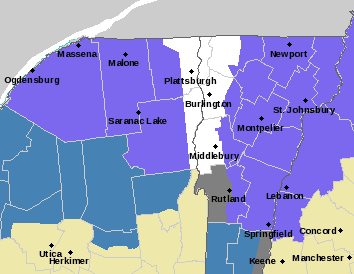As I like to do at the end of each month, here is my recap of the weather at Burlington International Airport (BTV) in South Burlington, VT for December 2020. In a future post, I'll take a look at Bradley International Airport's December weather.
Temperatures
We started the month on a warm note, with the temperature reaching 66 °F at BTV on December 1. While setting a Dec 1 record, that temperature reading fell 2 degrees shy of the record December high temperature at BTV, which is 68 °F set in 2015.
As a whole, December was a warm month at BTV. The mean monthly temperature was 31.3 °F, when the normal value is 25.8 °F, giving a mean temperature departure from normal of 5.5 °F for the month. We only had 8 days where the maximum temperature was less than or equal to 32 °F, and in an "average" month, we would have seen 13.3 of those days. Also of note, there were no days when the temperature dropped below 0 this December.
This temperature graph gives a good sense of the warm temperatures that BTV experienced this year, with an especially warm period around the start of the month and around Christmas day. In fact, BTV set a record high Christmas day temperature of 65 °F, surpassing the previous record of 62 °F set in 1964.
 |
| (NOAA Regional Climate Centers/xmACIS) |
December 2020 was the 9th warmest December on record, falling far behind December 2015, which had a mean temperature of 39.2 °F.
 |
| Burlington Area mean Dec temperatures since 1900 (NOAA Regional Climate Centers/xmACIS) |
Precipitation
It was a drier than normal month for the Burlington area, with 1.27 inches of total precipitation falling, when the normal value is 2.38 in.
 |
(NOAA Regional Climate Centers/xmACIS)
|
Christmas Day was the wettest day of the month, with 0.40 in. of rain falling.
While much of the Northeast is no longer experiencing drought conditions, abnormally dry conditions persist at BTV.
 |
| (National Drought Mitigation Center) |
SnowfallBTV saw 8.2 inches of snow this December, when a formal December would have 17.9 inches, giving a departure from normal of -9.7 inches.
The greatest snowfall at BTV was on December 17th, when a large Nor'easter pummeled parts of Vermont with over 40 inches of snow. Burlington was a bit too far north to get in on the action, though the airport did record 2.5 inches of snow that day.
Overall, the last month of 2020 was an uneventful one at BTV, characterized by warmth and a few extremely warm days that set records. BTV has seen less than 50% of its normal snowfall at this point in the season, so lets hope that changes as we move into the new year.

































